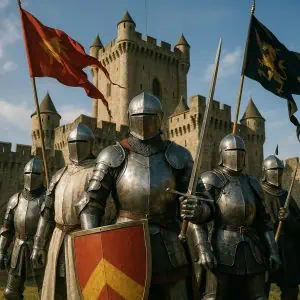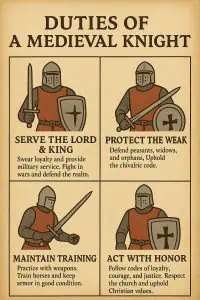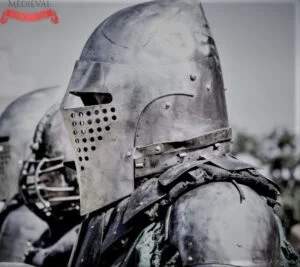Medieval knights’ armor was more than just protection—it symbolized status, wealth, and battlefield superiority. Over the centuries, armor evolved from simple chainmail to the iconic full plate armor of the late Middle Ages. Each piece, from the helmet and breastplate to gauntlets and greaves, was designed to safeguard vital areas while allowing for mobility in combat. Knights often personalized their armor with engravings or heraldic symbols to display their allegiance and heritage. Beyond its function in war, knightly armor played a vital role in ceremonies, tournaments, and public appearances, representing the chivalric ideal and the prestige of the warrior class.


A knight’s armor was not only a crucial element in medieval warfare but also a symbol of social status, as only wealthy knights could afford the expensive armor and equipment required for battle. In medieval times, knight armor was categorized into three main types based on its function: field armor, ceremonial armor, and jousting armor. Field armor was specifically designed for combat, emphasizing lightness and flexibility to allow knights mobility on the battlefield while still providing strong protection. This combination of durability and maneuverability made it the preferred choice for active military engagements.

Ceremonial Armour As the name suggests was designed for ceremonies and this is why in general it was adorned with silver, copper, gold, or cloth. The appearance was extremely important.

Jousting or Tournament Knight Armor *This armor was specially created to offer protection, even if it meant to overlook the mobility factor.


Knights Armor – Parts
It is common knowledge that back in the medieval times’ knights represented an elite warrior group and this is why armorers produced armor that was functional and decorative. Here are the parts that formed a knight’s suit of armor.
Helmet
One of the most basic parts of the knight’s armor might incorporate a visor that could be pulled down while in combat, in order to protect the face.













Full Plate Armour
Full Plate Armour was created around the end of the 13th century, first as a reinforcement for mail defenses and afterward simply defenses.
Plate armor as a full suit that we recognize and the knight in shining armor today didn’t take place until quite late in the medieval period.

The golden era of the fully plated knight in shining armor was during the 15th century onward

A knight in full plate armor would weigh in at around 50 lbs, full plate armor was specially created to safely protect the medieval Knights, but light and flexible enough for fast mobility.

Knights Armor Weapons
During the Medieval Ages, a wide variety of weapons were created and developed specially designed to be used in battle by gallant knights.
The sword was a standard fighting weapon that was created before the appearance of the medieval knight.
That being said, the sword became intertwined with the gallant and mythical identity of the Knight and became a legendary weapon that was worshiped in medieval times.

The knightly sword was double-edged, made out of mild steel, and commonly engraved with a prayer or the sword owner’s name.

Lance
The Lance was commonly made of wood, with a sharp metal tip, lances in later medieval times were developed a stouter appearance and allowed the knight to take advantage of his superior position while riding a horse. In case it broke or the knight dropped it, he could rely on his sword.



Other efficient weapons used by Knights were Polearm weapons such as the poleaxe and Maul and shorter weapons such as the mace and short war hammer.

Knights Armor Advantages
Protection
The main advantage the knight’s armor provided. The opponent commonly had to aim at specific gaps in the armor (armpits and neck) in order to injure or kill the knight.

Identification
Armor represented a status symbol that distinguished him from normal soldiers, Knights also had the custom and honor of adding their family crest Coat of Arms on the armor.


Knights Armour Disadvantages
Weight
Armor weighed between 40 and 60 pounds, thus creating huge disadvantages when it came to hand-to-hand combat.
Maneuverability
Armour was relatively limited. The joints were quite stiff and it became difficult to move and engage in quick combat. It depended on each knight’s strength.
Breathability and Vision
The helmet had small slits or holes where the eyes and mouth were, thus leaving little room to see and making it difficult for air to come inside.
Heat
Armour was made of metal and the knight commonly also wore chain-mail and quilted padding with the plate armor, which was very hot inside.
📜 Frequently Asked Questions: Medieval Knights Armor
What was the purpose of medieval knights armor?
The primary purpose of **medieval knights armor** was to protect knights from **swords, arrows, and other weapons** during battle while allowing mobility.
What types of armor did medieval knights wear?
Knights wore **chainmail**, **plate armor**, and **padded garments** called gambesons. Over time, **full plate armor** became the standard for elite knights.
What materials were used in knights armor?
Armor was typically made of **iron or steel**, often reinforced with **leather and cloth padding** to absorb impact and reduce injury.
How heavy was a full suit of knight armor?
A complete suit of **plate armor** usually weighed between **45-60 pounds (20-27 kg)**, designed to distribute weight evenly for mobility in battle.
Did knights wear armor under their clothes?
Knights wore **gambesons**, thick padded garments, under their **chainmail or plate armor** to prevent chafing and absorb blows.
How did knights maintain their armor?
Armor required regular **cleaning, oiling, and repair** to prevent rust and ensure it remained functional during battles or tournaments.
When did full plate armor become popular?
**Full plate armor** became widespread in the **late 14th and early 15th centuries**, offering superior protection and mobility compared to earlier chainmail.
Did all knights wear the same armor?
No, armor varied based on **wealth, rank, and purpose**, with elite knights wearing **custom plate armor** while lower-ranking soldiers often wore **simpler chainmail**.
⚔️ Test Your Knowledge: Medieval Knights Armor






